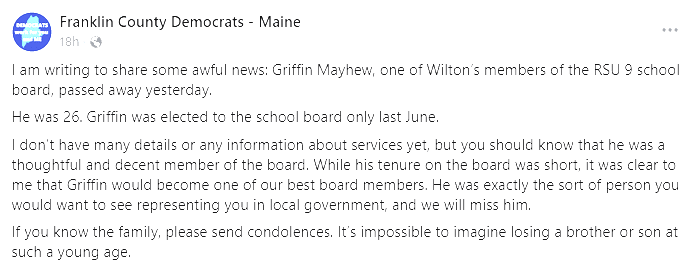Maine
Maine’s transportation system barely exists | Opinion

Maine’s transportation system is broken.
If you do not have a car, there is virtually no access to your job, schooling or basic necessities. If you do have a car, its high costs strain your household budget.
The comparison I draw is not some academic hypothetical — they affect your friends, neighbors and family. A grandmother who can no longer drive, a child who does not have a license, a friend who cannot afford a car. Even if you are fortunate enough to not be in this situation, consider your reaction when you shell out hundreds of dollars for new tires, or the dread of your annual inspection.
These stories are not rare. Transportation in Maine is riddled with numerous accessibility issues. A recent report, of which I am a co-author, put these challenges into actual numbers, which exemplifies the striking gap in access. First, approximately 90,000 Maine adults lack a driver’s license. Many are in their 20s, a critical age for accessing employment and educational opportunities. Second, 52,000 Mainers live in households where the number of workers exceeds the number of vehicles. With few alternatives available, this is as good as unreliable.
However, one of the most shocking figures is that 3 in 5 Maine adults experience transportation insecurity. This includes people who find their transportation unreliable, inaccessible and unaffordable.
The findings in the Public Transit Advisory Council report confirm we have a broken transportation system. This is a direct result of failed policy perpetuated by the governor’s administration. Maine Department of Transportation Commissioner Bruce Van Note has made decisions that weaken transportation alternatives and push forward expensive and disastrous projects.
The recent swell in public momentum for meaningful transportation reform serves as a pivotal moment for decision-makers — and they should act upon it.
There are several key areas that would need serious change: fiscal responsibility, agency transparency and robust investment in transportation alternatives. First and foremost, the highway budget faces significant shortfalls, most recently $280 million, which is in large part due to the diminishing role of fuel taxes. The Tax Foundation projects real fuel tax revenues to decline by more than half over the next 20 years.
Overall, 42.6% of Highway Fund revenue comes from fuel taxes, making the future of the fund a pressing concern. The PTAC report highlights several options, such as phasing out fuel taxes in favor of a mileage-based fee, restructuring the income tax and several smaller transit-dedicated revenue sources.
Second, in its stumbling attempts to advance a decades-old proposal for a new toll highway extension to Gorham, the Maine Turnpike Authority has made itself a poster child for nontransparency. Freedom of Information Act requests from journalists, activists and citizens at risk of losing their homes to make way for the highway have documented false claims.
These include:
• Publicly understating the estimated cost of the highway at its public rollout last year by over $100 million.
• Claiming that traffic continues to grow when DOT’s own public data shows traffic counts flat or even falling.
• Withholding the results of a public opinion poll showing more local opposition than support for the highway.
• Failing to disclose the likely historic preservation eligibility of a farm in the route of the highway.
All of these tactics only serve to overstate the necessity and value of a $331 million new highway, while the state DOT claims it doesn’t have the money it needs to maintain the roads we already have.
Finally, MaineDOT has starved transportation alternatives of crucial funding, leaving service providers to fight over a meager pot. For example, Commissioner Van Note has flatlined transit
funding for years, leading to a major gap between the level of service needed and provided.
According to a John T. Gorman Foundation report, 28 million transit trips are needed in Maine, yet only 3 million trips are provided. The state is an underutilized source of funding, currently contributing a mere 2% of total transit funding.
At this crossroads, Maine has a chance to reshape its transportation future. It is time for the public to take action on their angst and tell leaders, like Commissioner Van Note, that it’s time to remake transit in our state.

Maine
Maine Commission releases first recommendations to combat growing deed fraud threat

PORTLAND (WGME) — Maine has spent the past two years grappling with a rise in deed fraud schemes.
The CBS13 I-Team first began investigating after an elderly man didn’t receive his tax bill and learned someone had transferred his property without his knowledge.
Since then, multiple landowners have come forward saying something similar almost happened to them. Our reporting has uncovered for-sale signs posted on land, fake driver’s licenses and signed agreements to transfer deeds; all tied to scam attempts.
Maine has spent the past two years grappling with a rise in deed fraud schemes. (The Nathanson family)
The growing pattern prompted a state commission to issue new recommendations aimed at stopping the fraud.
Landowners say scam nearly cost them their property
Two summers ago, Cheryl and Ralph Nathanson learned their land on Little Sebago Lake had been put up for sale online.
“We could have lost our property,” Cheryl Nathanson said.
The Nathansons, who live in Connecticut, were stunned when they discovered a fraudulent listing for their Maine plot.
“We notified the police and they said they can take a report on it but that there’s nothing they could really do,” Ralph Nathanson said.
Police told them it was a classic case of deed fraud: scammers posing as property owners, listing land they don’t own and disappearing with the cash.
The couple was advised to sign up for property alerts through the Cumberland County Registry of Deeds, but quickly learned those alerts offered little protection.
“You can register for the deed fraud but it only informs you, by email, after the deed has been transferred. So it’s basically worthless,” Ralph Nathanson said.
A realtor lists their property…. Again
The following summer, the Nathansons discovered a real estate sign had been placed on their land.
“I was notified by a neighbor that there was a for-sale sign, a realtor for-sale sign, on our land,” Ralph Nathanson said.
A realtor from Old Orchard Beach had unknowingly entered into an agreement with someone impersonating the couple.
“Some of the information was correct, some of it wasn’t. You can get anything off of Google,” Cheryl Nathanson said.
Ralph Nathanson remembers confronting the agent.
“You are selling my property and I’m not selling the property,” Ralph Nathanson said. “The phone went silent.”
Despite the ordeal, the couple believes they were lucky to have seen the sign, knowing how bad these schemes can get.
State commission concludes work on deed fraud
“Currently, you all might be landowners and your land might be at risk, and you might not know right now that somebody has sold your land,” Jane Towle with the Real Estate Commission said, during the final meeting of the Deed Fraud Commission.
This fall, a state commission of stakeholders convened to examine ways to prevent deed fraud in Maine.
The Nathansons urged the commission to go beyond awareness campaigns.
CBS13 I-Team Reporter Stephanie Grindley: “You think the state should act beyond just awareness?”
Cheryl Nathanson: “100%.”
Ralph Nathanson: “Absolutely. I think the state of Maine has a responsibility to protect landowners.
But not everyone in the meeting agreed on the scope of the problem.
Attorney General calls deed fraud a low-priority scam
In the final meeting, Attorney General Aaron Frey remained staunch in his skepticism, saying complaints of deed fraud are still relatively rare.
“What we’re seeing for people getting hurt and losing money, this would probably not be the thing I want to highlight over other scams that are happening right now that are actually costing people their retirement savings,” Frey said.
Sen. Henry Ingwersen of York, who spearheaded the commission, sat down with the I-Team following the final meeting.
Grindley: “During the meeting, I did hear the Attorney General essentially call this a non-issue. His office isn’t getting complaints. He doesn’t see a bunch of consumers loosing money to this. Has that changed your stance?”
Ingwersen: “We’ve had three that have really been highlighted just in southern Maine. We haven’t heard a lot from around the rest of the state, but there has been some, so I think that even though it’s rare, we really need to address it.”
“I was pleased that we did come up with a couple of recommendations that we’re going to put in the report,” Ingwersen said.
Key Recommendation: Verify the seller’s identity
The first area of agreement among most, not all, stakeholders would legally require listing agents to verify a seller’s identity.
“The way it is now, it’s best practice. And a lot of professionals are doing best practice,” Ingwersen said. “The red flags in deed fraud are cash sale, land only, a quick sale at below-market value If we had realtors really paying attention to those red flags but also a policy that would require them to check the identity of the fraudulent seller, or of the seller, thoroughly, I think it would prevent, even if it prevented one instance of deed fraud, I think it would be very helpful.”
The commission did not outline exactly how identification should be verified.
“We didn’t really specify what that identification process was going to be. We’re leaving that up to rule making,” Ingwersen said.
Second Recommendation: Easier path to undo a fraudulent deed
Currently, the only way to reverse a fraudulent deed in Maine is to go to court.
The commission proposes allowing an attorney to file an affidavit with the registry.
“Allow an attorney to file an affidavit with the deed recorder that would allow the deed to be, the fraudulent deed, to be nullified in a way that is a little bit quicker than we currently have,” Ingwersen said.
The recommendations will now head to the Legislature’s Judiciary Committee. Any legislative change likely wouldn’t take effect until 2027, if the proposals make it into a bill and then survive a vote.
“I think we made some good progress, but I don’t think this is going to go away. I think this will continue,” Ingwersen said.
Landowners fear fraud will try until it succeeds
“We were thinking, do we take a loan out on it just to secure it?” Ralph Nathanson said.
As the legislative process begins, the Nathansons say Maine cannot wait. They fear it’s only a matter of time before a sale of their land goes through.
“To lose land like this or to find out that their land is now gone, I just can’t imagine that,” Ralph Nathanson said.
Ideas Left on the Table: Title Freeze and National Guidance
Several proposals failed to gain traction, including a “title freeze.” a concept similar to a credit freeze that would allow a landowner to lock their deed from unauthorized transfers. Maine could have been the first state to pilot it, but members said they lacked enough information.
Instead, they pointed to national group studying deed fraud. The Uniform Law Commission is drafting model legislation that states, including Maine, could adopt to better protect landowners.
Maine
Charter Communications lays off 176 Maine employees

PORTLAND, Maine (WGME) — Charter Communications, which owns Spectrum, is laying off 176 workers in Maine.
A company spokesperson said 176 employees were informed on Wednesday about the layoffs.
Charter Communications said it is transitioning the work done at the Portland call center to other U.S.-based centers effective immediately.
“Employees may relocate in their current role to select customer service locations and are eligible for relocation benefits. They will continue to receive regular pay for 90 days; severance and eligible benefits will begin afterward for those who do not relocate. Impacted employees may also apply for any open role for which they are qualified,” a company spokesperson said.
According to the Press Herald, the layoff is about a quarter of their Maine workforce.
Maine
Recently Elected 26-Year-Old Wilton School-Board Member Dies Unexpectedly

Regional School Unit (RSU) 9 school board member Griffin Mayhew, 26, representing Wilton, died unexpectedly on Monday, just months after he first took office in June.
[ Community Split Over Mt. Blue Principal’s Halloween Costume, But RSU 9 Confirms Black is Back on the Job…]
“Griffin was an exemplary young man whose commitment, kindness, and thoughtfulness were evident throughout his service on the Board along with his support of student activities at Mt. Blue Campus.
RSU 9, also known as the Mt. Blue Regional School, serves Chesterville, Farmington, Industry, New Sharon, New Vineyard, Starks, Temple, Vienna, Weld, and Wilton. Griffin became one of Wilton’s three RSU 9 Board of Directors members after defeating opponent Douglas Hiltz in a 209-146 vote.
The incumbent board member did not run for reelection.
Out of respect for Mayhew’s memory, the school district postponed the meeting scheduled for Tuesday.
“I don’t have many details or any information about services yet, but you should know that he was a thoughtful and decent member of the board. While his tenure on the board was short, it was clear to me that Griffin would become one of our best board members. He was exactly the sort of person you would want to see representing you in local government, and we will miss him,” said the Franklin County Democrats on Facebook.

Mayhew’s cause of death has not been released.

-

 Alaska6 days ago
Alaska6 days agoHowling Mat-Su winds leave thousands without power
-

 Politics1 week ago
Politics1 week agoTrump rips Somali community as federal agents reportedly eye Minnesota enforcement sweep
-
Ohio1 week ago
Who do the Ohio State Buckeyes hire as the next offensive coordinator?
-

 Texas6 days ago
Texas6 days agoTexas Tech football vs BYU live updates, start time, TV channel for Big 12 title
-

 News1 week ago
News1 week agoTrump threatens strikes on any country he claims makes drugs for US
-

 World1 week ago
World1 week agoHonduras election council member accuses colleague of ‘intimidation’
-

 Washington3 days ago
Washington3 days agoLIVE UPDATES: Mudslide, road closures across Western Washington
-

 Iowa5 days ago
Iowa5 days agoMatt Campbell reportedly bringing longtime Iowa State staffer to Penn State as 1st hire















